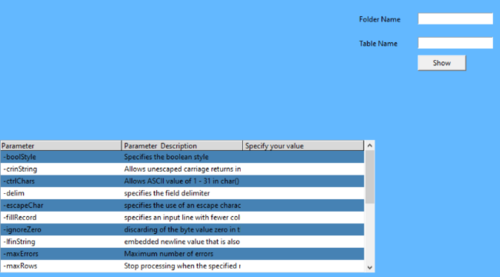使用 tkinter 进行 Python GUI 编程
我有一个有多行的表单。按 Enter 键会打开一个选项窗口。但每次我按回车键时,它都会打开一个新的选项窗口。我如何控制和检查选项窗口是否打开然后不打开选项窗口。
import tkinter as tk
from tkinter import ttk
from tkinter import *
from tkinter import messagebox
# Directory/File processing libraries
import os
import configparser
import csv
def callback():
#messagebox.showinfo("Netezza", Folder_Name_var.get())
#messagebox.showinfo("Netezza", Table_Name_var.get() )
config = configparser.ConfigParser()
config.read('C:\\aa\\config.ini')
#for value in config['Folder']: print(value)
for key in config.items('Folder'):
print (key[1].replace('{Folder_Name}',Folder_Name_var.get()))
os.makedirs(key[1].replace('{Folder_Name}',Folder_Name_var.get()),exist_ok=True)
def click_tv(event):
#messagebox.showinfo("Inside")
selected=trv.focus()
print(trv.item(selected))
def press_enter(event):
#messagebox.showinfo("Inside")
selected=trv.focus()
print(trv.item(selected))
print(str((event.keysym)))
if str((event.keysym))=='Return':
option_wnd=Toplevel(root)
option_wnd.geometry('200x200')
option_wnd.title('Option Window')
option_wnd.grab_set()
#option_wnd.pack()
def selection_change(event):
selected = trv.selection()[0]
print('You clicked on', trv.item(selected))
#option_wnd.mainloop()
root = Tk()
Folder_Name_var = tk.StringVar()
Table_Name_var = tk.StringVar()
# This is the section of code which creates the main window
root.geometry('873x498')
root.configure(background='#63B8FF')
root.title('Automation Software - Blue Shield of California')
pic= Canvas(root, height=100, width=100)
#pic= Canvas(root, height=225, width=580)
#picture_file = PhotoImage(file = 'c:\\aa\\bsc.png')
#pic.create_image(0, 0, anchor=NW, image=picture_file)
#pic.place(x=5, y=5)
每次我在根窗口上按 Enter 键时,都会打开一个弹出窗口。我需要控制它。如果弹出窗口打开,那么我们不应该允许另一个弹出窗口打开。

 婷婷同学_
婷婷同学_4回答
-

繁华开满天机
直接的方法是使用winfo_exists():root.option_wnd = None # Init valuedef press_enter(event): #messagebox.showinfo("Inside") selected=trv.focus() print(trv.item(selected)) print(str((event.keysym))) if str((event.keysym))=='Return': if root.option_wnd and root.option_wnd.winfo_exists(): root.option_wnd.lift() # make this window on the top. else: # create this window root.option_wnd = tk.Toplevel(root) .....但我认为你不需要每次用户输入时都创建这个窗口。Enter在开始时创建它,只需在用户输入时显示它Enter例如:root = tk.Tk()option_wnd = tk.Toplevel()option_wnd.wm_protocol("WM_DELETE_WINDOW", option_wnd.withdraw) # when user try to close this window, hide it instead of destroy it.....option_wnd.withdraw() # hide this windowdef press_enter(event): #messagebox.showinfo("Inside") selected=trv.focus() print(trv.item(selected)) print(str((event.keysym))) if str((event.keysym))=='Return': option_wnd.deiconify() # show it. -

缥缈止盈
我能想到的一个选项是像这样绑定选项窗口:option_wnd.bind('<Return>', lambda e: option_wnd.close()) # or withdraw() or quit() ?将选项窗口绑定到按下 Enter 键时它会关闭(尽管我不知道上述函数的差异(有,所以你应该查找)),但是如果你想使用Enter(返回)输入值,这可能会妨碍你键,因为它将关闭窗口。另一个选项是将选项窗口绑定到此事件:option_wnd.bind('<FocusOut>', lambda e: option_wnd.close())这是当窗口不再受到关注时,因此如果您按 Enter 键,它将打开一个新窗口,但仍然打赌旧窗口应该关闭。您也可以尝试用某些东西进行一些逻辑编程,例如当输入按下“打开”模式时,再次按下它不会打开窗口,而当您关闭现有窗口时,它将再次允许这种情况。 -

ITMISS
def press_enter(event): #messagebox.showinfo("Inside") root.deiconify () selected=trv.focus() print(trv.item(selected)) print(str((event.keysym))) if str((event.keysym))=='Return': option_wnd=Toplevel(root) option_wnd.geometry('200x200') option_wnd.title('Option Window') option_wnd.grab_set() #option_wnd.pack() -

慕运维8079593
如果您不使用类,您可以执行以下操作:options_displayed = False #globaldef option_closed(w): global options_displayed w.destroy() #close the actual window options_displayed = False # log the fact it is now closedef press_enter(event): global options_displayed # reference global variable #messagebox.showinfo("Inside") selected=trv.focus() print(trv.item(selected)) print(str((event.keysym))) if str((event.keysym))=='Return' and not options_displayed: option_wnd=Toplevel(root) option_wnd.geometry('200x200') option_wnd.title('Option Window') option_wnd.grab_set() option_wnd.grab_set() option_wnd.protocol("WM_DELETE_WINDOW", lambda w= option_wnd :option_closed(w))
 随时随地看视频慕课网APP
随时随地看视频慕课网APP
相关分类




 Python
Python